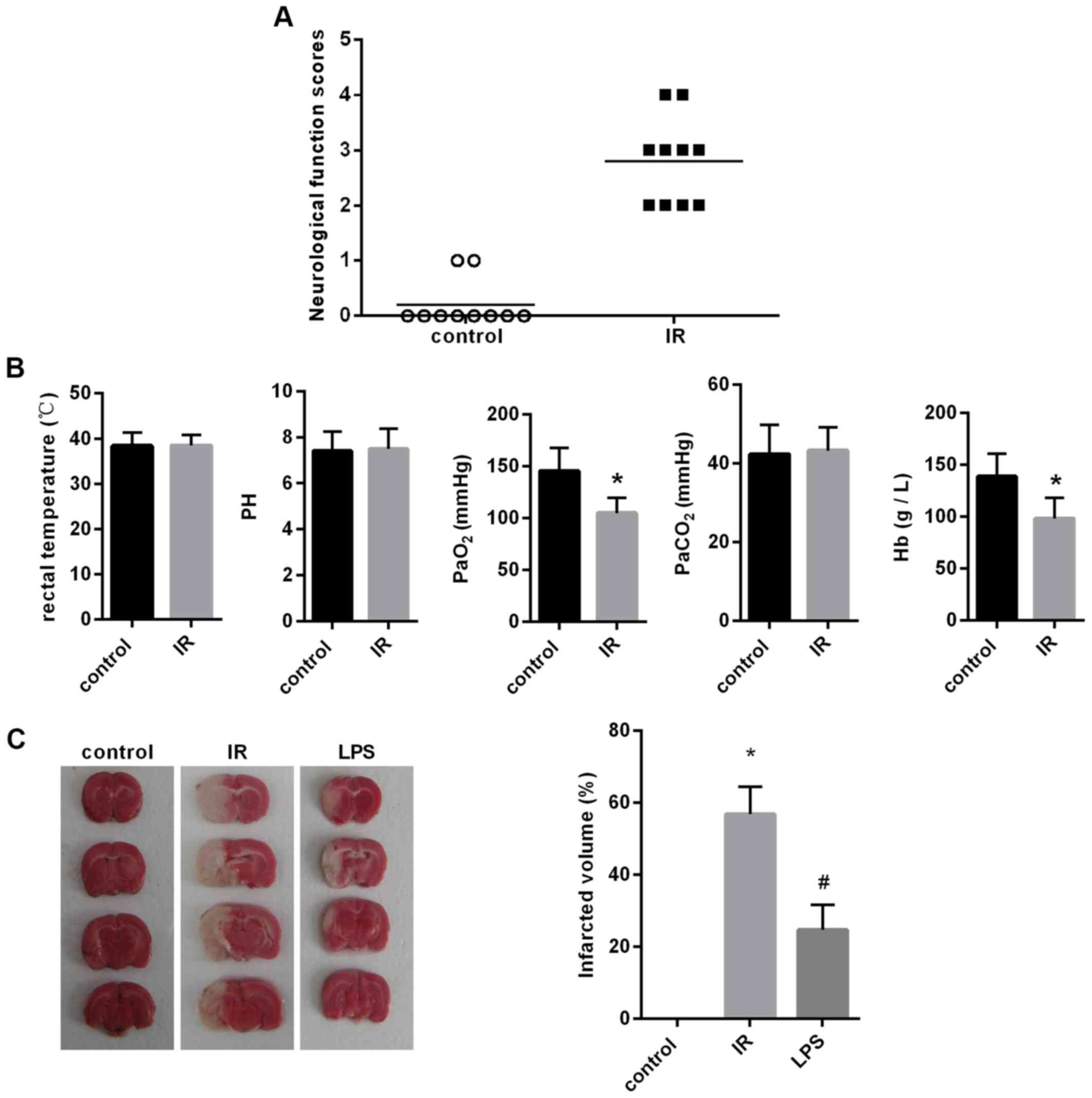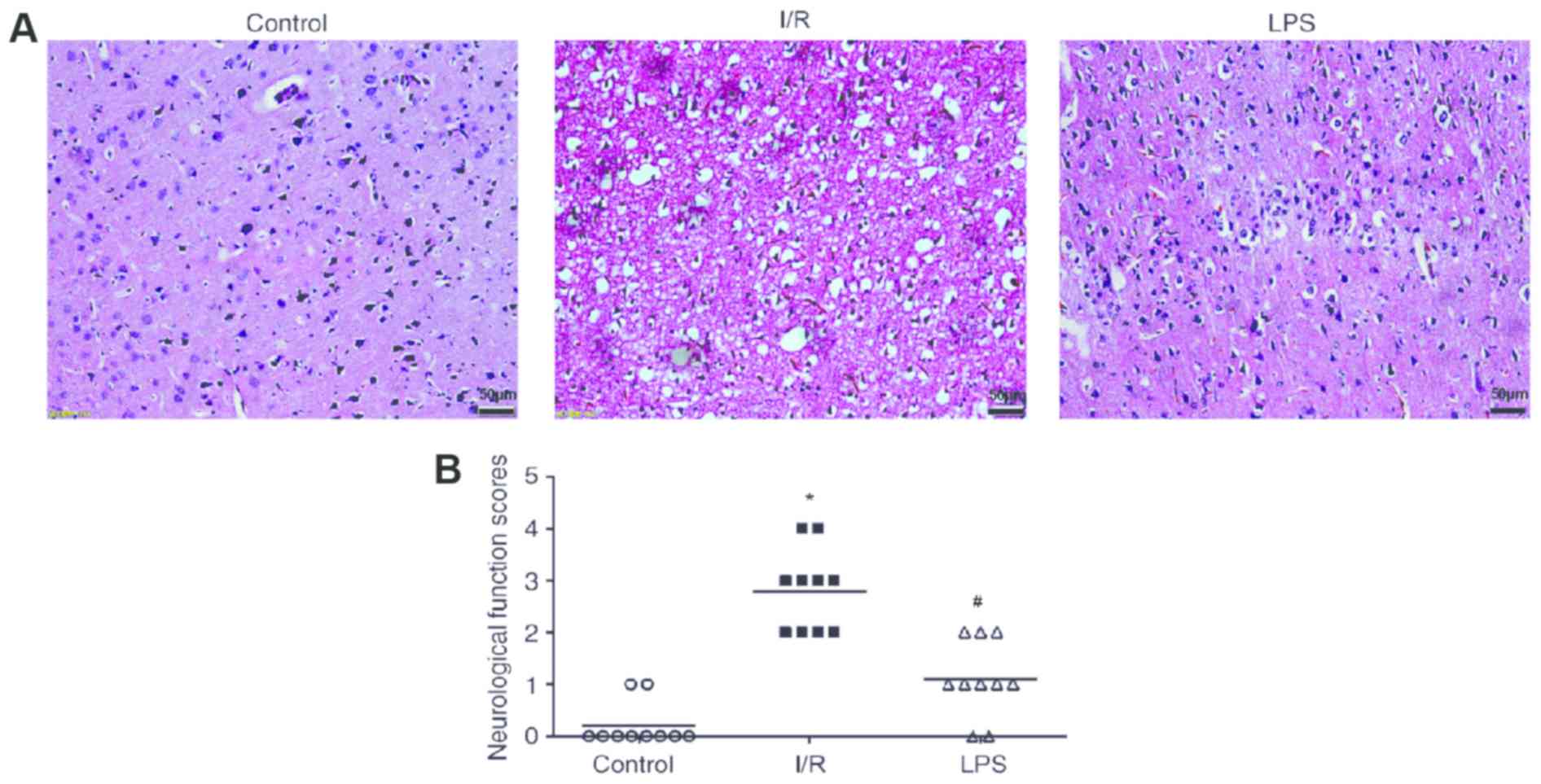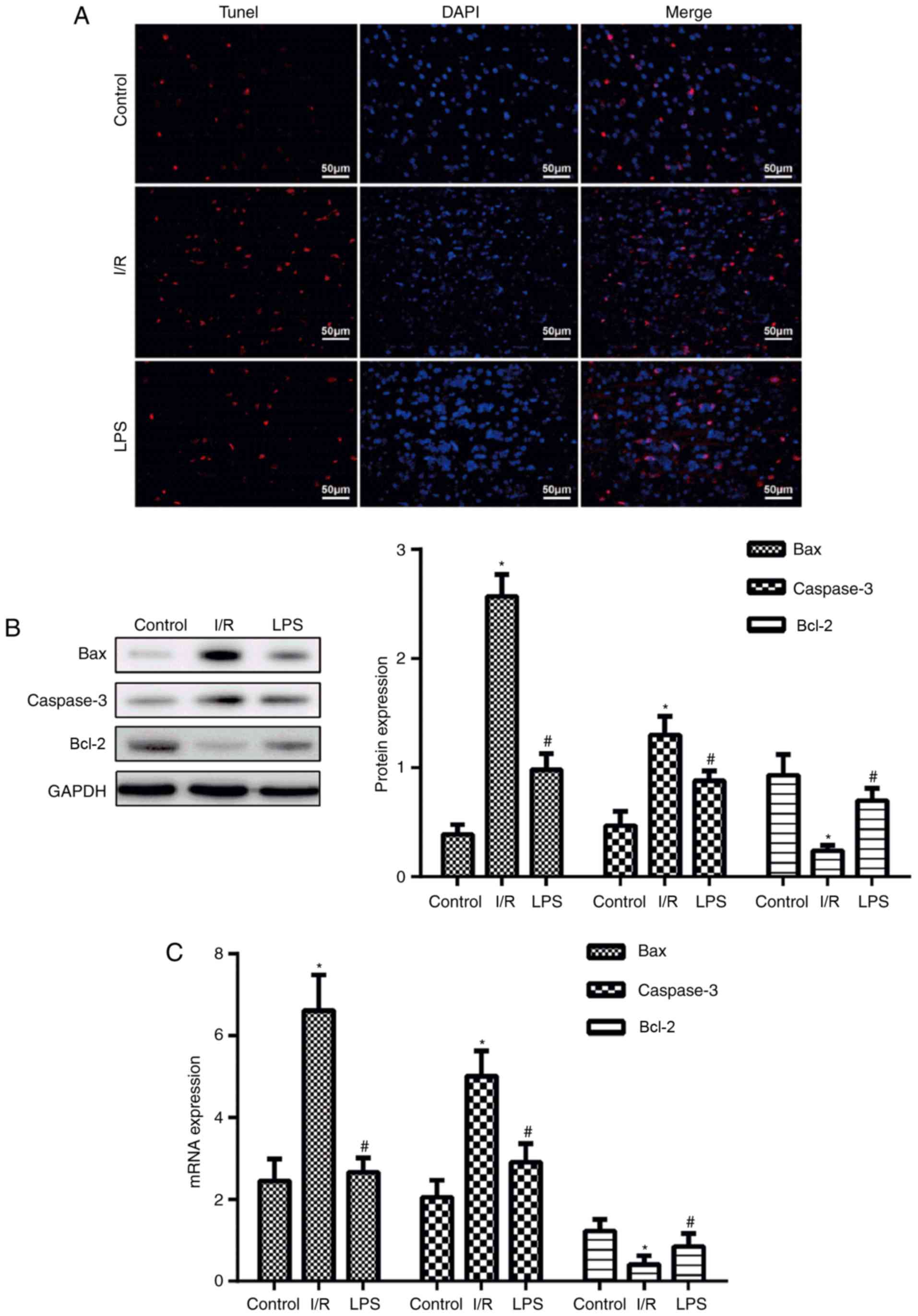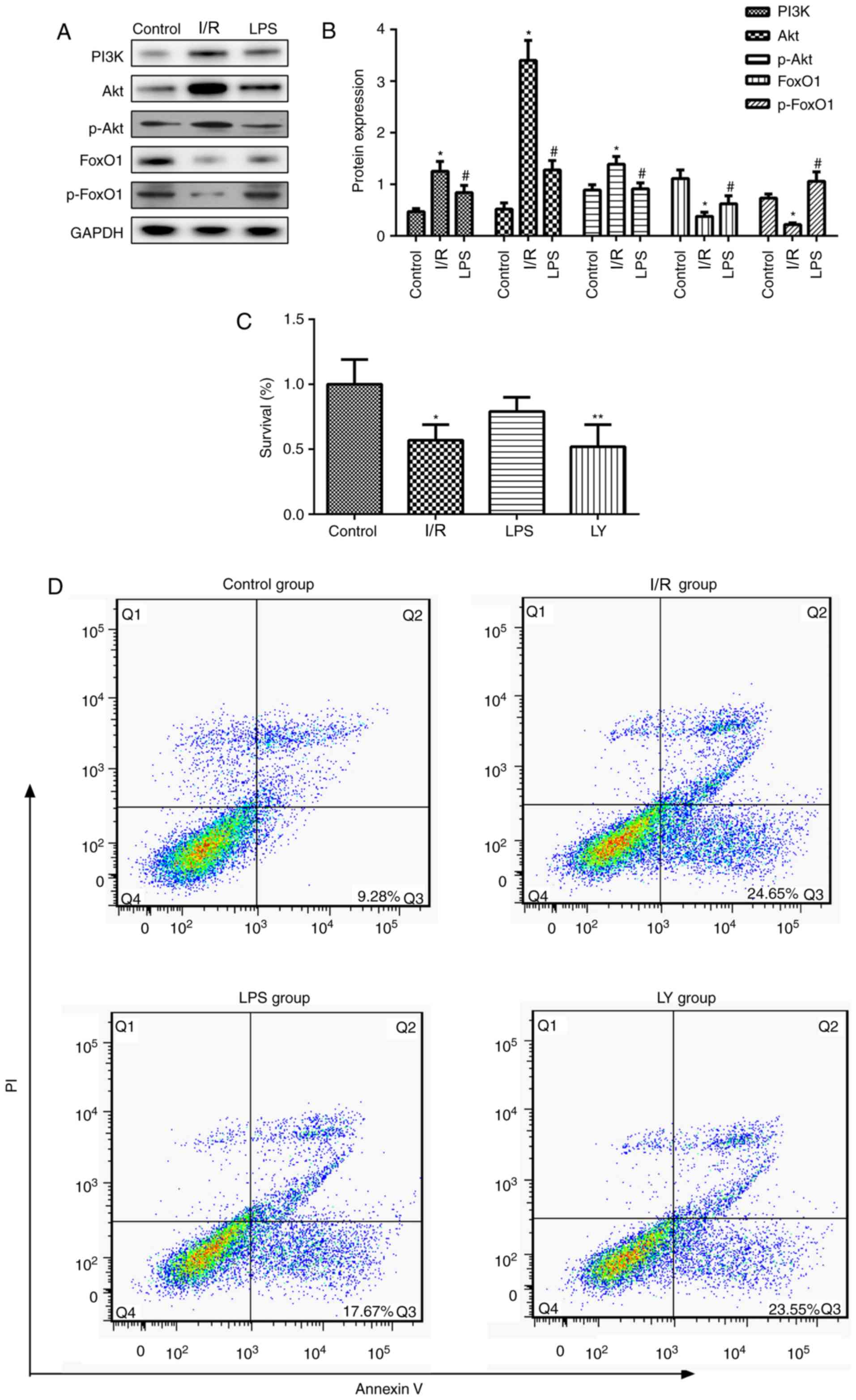|
1
|
Bhaskar S, Stanwell P, Cordato D, Attia J
and Levi C: Reperfusion therapy in acute ischemic stroke: Dawn of a
new era? BMC Neurol. 18:82018. View Article : Google Scholar : PubMed/NCBI
|
|
2
|
Wang Q, Dai P, Bao H, Liang P, Wang W,
Xing A and Sun J: Anti-inflammatory and neuroprotective effects of
sanguinarine following cerebral ischemia in rats. Exp Ther Med.
13:263–268. 2017. View Article : Google Scholar : PubMed/NCBI
|
|
3
|
Wang SL, Duan L, Xia B, Liu Z, Wang Y and
Wang GM: Dexmedetomidine preconditioning plays a neuroprotective
role and suppresses TLR4/NF-κB pathways model of cerebral ischemia
reperfusion. Biomed Pharmacother. 93:1337–1342. 2017. View Article : Google Scholar : PubMed/NCBI
|
|
4
|
Bai S, Sun Y, Wu L, Wu Z and Fang M:
Tripotolide ameliorates inflammation and apoptosis induced by focal
cerebral ischemia/reperfusion in rats. Zhejiang Da Xue Xue Bao Yi
Xue Ban. 45:493–500. 2016.(In Chinese). PubMed/NCBI
|
|
5
|
Sasaki H, Galang N and Maulik N: Redox
regulation of NF-kappaB and AP-1 in ischemic reperfused heart.
Antioxid Redox Signal. 1:317–324. 1999. View Article : Google Scholar : PubMed/NCBI
|
|
6
|
Zhang L, Qu Y, Tang J, Chen D, Fu X, Mao M
and Mu D: PI3K/Akt signaling pathway is required for
neuroprotection of thalidomide on hypoxic-ischemic cortical neurons
in vitro. Brain Res 1357. 157–165. 2010.
|
|
7
|
Cui XB, Wang C, Li L, Fan D, Zhou Y, Wu D,
Cui QH, Fu FY and Wu LL: Insulin decreases myocardial adiponectin
receptor 1 expression via PI3K/Akt and FoxO1 pathway. Cardiovasc
Res. 93:69–78. 2012. View Article : Google Scholar : PubMed/NCBI
|
|
8
|
Cao YT, Zhou L, Wu HT, Li XM, Huang WT,
Chen XL, Li C and Tao L: The clinical characteristics and treatment
outcomes of 386 patients with hypopharyngeal cancer. Zhonghua Er Bi
Yan Hou Tou Jing Wai Ke Za Zhi. 51:433–439. 2016.(In Chinese).
PubMed/NCBI
|
|
9
|
Huang CY, Hsiao JK, Lu YZ, Lee TC and Yu
LC: Anti-apoptotic PI3K/Akt signaling by sodium/glucose transporter
1 reduces epithelial barrier damage and bacterial translocation in
intestinal ischemia. Lab Invest. 91:294–309. 2011. View Article : Google Scholar : PubMed/NCBI
|
|
10
|
Chu SF, Zhang Z, Zhang W, Zhang MJ, Gao Y,
Han N, Zuo W, Huang HY and Chen NH: Upregulating the Expression of
Survivin-HBXIP Complex Contributes to the Protective Role of
IMM-H004 in transient global cerebral ischemia/reperfusion. Mol
Neurobiol. 54:524–540. 2017. View Article : Google Scholar : PubMed/NCBI
|
|
11
|
Wyns H, Plessers E, De Backer P, Meyer E
and Croubels S: In vivo porcine lipopolysaccharide inflammation
models to study immunomodulation of drugs. Vet Immunol
Immunopathol. 166:58–69. 2015. View Article : Google Scholar : PubMed/NCBI
|
|
12
|
Zhou B, Weng G, Huang Z, Liu T and Dai F:
Arctiin prevents LPS-induced acute lung injury via inhibition of
PI3K/AKT signaling pathway in mice. Inflammation. 2018.(Epub ahead
of print). View Article : Google Scholar
|
|
13
|
Delayre-Orthez C, de Blay F, Frossard N
and Pons F: Dose-dependent effects of endotoxins on allergen
sensitization and challenge in the mouse. Clin Exp Allergy.
34:1789–1795. 2004. View Article : Google Scholar : PubMed/NCBI
|
|
14
|
Ronco C: Lipopolysaccharide (LPS) from the
cellular wall of Gram-negative bacteria, also known as endotoxin,
is a key molecule in the pathogenesis of sepsis and septic shock.
Preface. Blood Purif. 37 Suppl 1:S12014. View Article : Google Scholar
|
|
15
|
Dai Y, Jia P, Fang Y, Liu H, Jiao X, He JC
and Ding X: miR-146a is essential for lipopolysaccharide
(LPS)-induced cross-tolerance against kidney ischemia/reperfusion
injury in mice. Sci Rep. 6:270912016. View Article : Google Scholar : PubMed/NCBI
|
|
16
|
Gong G, Huang Y, Yuan LB, Hu L and Cai L:
Requirement of LRG in endotoxin-mediated brain protection. Xi Bao
Yu Fen Zi Mian Yi Xue Za Zhi. 27:865–867. 2011.(In Chinese).
PubMed/NCBI
|
|
17
|
Augestad IL, Nyman AKG, Costa AI, Barnett
SC, Sandvig A, Håberg AK and Sandvig I: Effects of neural stem cell
and olfactory ensheathing cell co-transplants on tissue remodelling
after transient focal cerebral ischemia in the adult rat. Neurochem
Res. 42:1599–1609. 2017. View Article : Google Scholar : PubMed/NCBI
|
|
18
|
Liu YZ, Wang C, Wang Q, Lin YZ, Ge YS, Li
DM and Mao GS: Role of fractalkine/CX3CR1 signaling pathway in the
recovery of neurological function after early ischemic stroke in a
rat model. Life Sci. 184:87–94. 2017. View Article : Google Scholar : PubMed/NCBI
|
|
19
|
Swanson RA, Morton MT, Tsao-Wu G, Savalos
RA, Davidson C and Sharp FR: A semiautomated method for measuring
brain infarct volume. J Cereb Blood Flow Metab. 10:290–293. 1990.
View Article : Google Scholar : PubMed/NCBI
|
|
20
|
Livak KJ and Schmittgen TD: Analysis of
relative gene expression data using real-time quantitative PCR and
the 2(-Delta Delta C(T)) method. Methods. 25:402–408. 2001.
View Article : Google Scholar : PubMed/NCBI
|
|
21
|
Chancellor BK and Ishida K: New standards
of care in ischemic stroke. J Neuroophthalmol. 37:320–331. 2017.
View Article : Google Scholar : PubMed/NCBI
|
|
22
|
Yang H, Yi Y, Han Y and Kim HJ:
Characteristics of cricopharyngeal dysphagia after ischemic stroke.
Ann Rehabil Med. 42:204–212. 2018. View Article : Google Scholar : PubMed/NCBI
|
|
23
|
Kim E, Tolhurst AT and Cho S: Deregulation
of inflammatory response in the diabetic condition is associated
with increased ischemic brain injury. J Neuroinflammation.
11:832014. View Article : Google Scholar : PubMed/NCBI
|
|
24
|
Yuksel S, Tosun YB, Cahill J and Solaroglu
I: Early brain injury following aneurysmal subarachnoid hemorrhage:
Emphasis on cellular apoptosis. Turk Neurosurg. 22:529–533.
2012.PubMed/NCBI
|
|
25
|
Huang L, Wan J, Chen Y, Wang Z, Hui L, Li
Y, Xu D and Zhou W: Inhibitory effects of p38 inhibitor against
mitochondrial dysfunction in the early brain injury after
subarachnoid hemorrhage in mice. Brain Res 1517. 133–140. 2013.
View Article : Google Scholar
|
|
26
|
Li T, Luo N, Du L, Zhou J, Zhang J, Gong L
and Jiang N: Tumor necrosis factor-alpha plays an initiating role
in extracorporeal circulation-induced acute lung injury. Lung.
191:207–214. 2013. View Article : Google Scholar : PubMed/NCBI
|
|
27
|
Zhang C, Wang JG, Zou WX and Tian WJ:
Clinical study on naomaltal capsule in treating lschemic cerebral
infarction. Guide Chinese Medicine. 6:742008.
|
|
28
|
Halladin NL: Oxidative and inflammatory
biomarkers of ischemia and reperfusion injuries. Dan Med J.
62:B50542015.PubMed/NCBI
|
|
29
|
Sperandeo P, Martorana AM and Polissi A:
Lipopolysaccharide biogenesis and transport at the outer membrane
of Gram-negative bacteria. Biochim Biophys Acta Mol Cell Biol
Lipids 1862. 1451–1460. 2017. View Article : Google Scholar
|
|
30
|
Li ZX, Li QY, Qiao J, Lu CZ and Xiao BG:
Granulocyte-colony stimulating factor is involved in low-dose
LPS-induced neuroprotection. Neurosci Lett. 465:128–132. 2009.
View Article : Google Scholar : PubMed/NCBI
|
|
31
|
Rosenzweig HL, Minami M, Lessov NS, Coste
SC, Stevens SL, Henshall DC, Meller R, Simon RP and Stenzel-Poore
MP: Endotoxin preconditioning protects against the cytotoxic
effects of TNFalpha after stroke: A novel role for TNFalpha in
LPS-ischemic tolerance. J Cereb Blood Flow Metab. 27:1663–1674.
2007. View Article : Google Scholar : PubMed/NCBI
|
|
32
|
Ding Y and Li L: Lipopolysaccharide
preconditioning induces protection against
lipopolysaccharide-induced neurotoxicity in organotypic midbrain
slice culture. Neurosci Bull. 24:209–218. 2008. View Article : Google Scholar : PubMed/NCBI
|
|
33
|
Qin T, Li N, Tan XF, Zheng JH, Tao R and
Chen MH: Works on heart, how about brain? Effect of hyperkalemia on
focal cerebral ischemia/reperfusion injury in rats. Eur Rev Med
Pharmacol Sci. 22:2839–2846. 2018.PubMed/NCBI
|
|
34
|
Jiang EP, Wang SQ, Wang Z, Yu CR, Chen JG
and Yu CY: Effect of schisandra chinensis lignans on neuronal
apoptosis and p-AKT expression of rats in cerebral ischemia injury
model. Zhongguo Zhong Yao Za Zhi. 39:1680–1684. 2014.(In Chinese).
PubMed/NCBI
|
|
35
|
Zhong JB, Li X, Zhong SM, Liu JD, Chen CB
and Wu XY: Knockdown of long noncoding antisense RNA brain-derived
neurotrophic factor attenuates hypoxia/reoxygenation-induced nerve
cell apoptosis through the BDNF-TrkB-PI3K/Akt signaling pathway.
Neuroreport. 28:910–916. 2017. View Article : Google Scholar : PubMed/NCBI
|
|
36
|
Li W, Yang Y, Hu Z, Ling S and Fang M:
Neuroprotective effects of DAHP and Triptolide in focal cerebral
ischemia via apoptosis inhibition and PI3K/Akt/mTOR pathway
activation. Front Neuroanat. 9:482015. View Article : Google Scholar : PubMed/NCBI
|
|
37
|
Theofilatos D, Fotakis P, Valanti E,
Sanoudou D, Zannis V and Kardassis D: HDL-apoA-I induces the
expression of angiopoietin like 4 (ANGPTL4) in endothelial cells
via a PI3K/AKT/FOXO1 signaling pathway. Metabolism. 87:36–47. 2018.
View Article : Google Scholar : PubMed/NCBI
|
|
38
|
Mattoon DR, Lamothe B, Lax I and
Schlessinger J: The docking protein Gab1 is the primary mediator of
EGF-stimulated activation of the PI-3K/Akt cell survival pathway.
BMC Biol. 2:242004. View Article : Google Scholar : PubMed/NCBI
|
|
39
|
Huang J, Kodithuwakku ND, He W, Zhou Y,
Fan W, Fang W, He G, Wu Q, Chu S and Li Y: The neuroprotective
effect of a novel agent N2 on rat cerebral ischemia associated with
the activation of PI3K/Akt signaling pathway. Neuropharmacology.
95:12–21. 2015. View Article : Google Scholar : PubMed/NCBI
|
|
40
|
Perkinton MS, Sihra TS and Williams RJ:
Ca(2+)-permeable AMPA receptors induce phosphorylation of cAMP
response element-binding protein through a phosphatidylinositol
3-kinase-dependent stimulation of the mitogen-activated protein
kinase signaling cascade in neurons. J Neurosci. 19:5861–5874.
1999. View Article : Google Scholar : PubMed/NCBI
|













